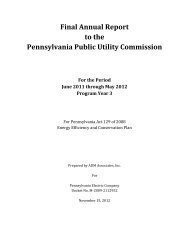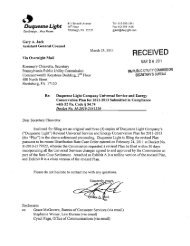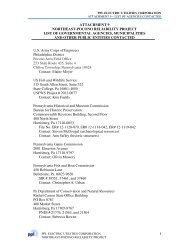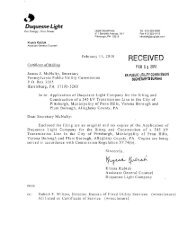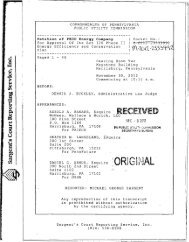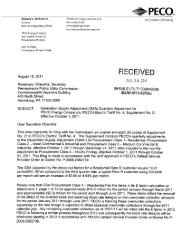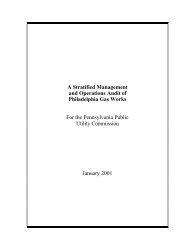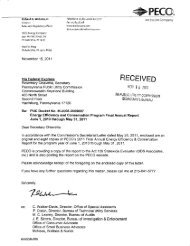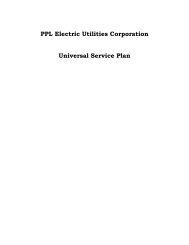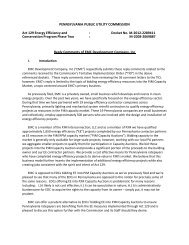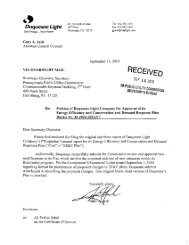Electric Power Outlook - Pennsylvania Public Utility Commission
Electric Power Outlook - Pennsylvania Public Utility Commission
Electric Power Outlook - Pennsylvania Public Utility Commission
You also want an ePaper? Increase the reach of your titles
YUMPU automatically turns print PDFs into web optimized ePapers that Google loves.
Section 3 – Regional Reliability<br />
Regional Reliability Assessments<br />
This section summarizes the regional reliability assessments of NERC, RFC and PJM for<br />
generation and transmission capability.<br />
The reliability of the interconnected bulk power system is defined in terms of two basic and<br />
functional aspects. Adequacy is the ability of the bulk power system to supply the aggregate<br />
electrical demand and energy requirements of the customer at all times, taking into account<br />
scheduled and reasonably expected unscheduled outages of system elements. Operating<br />
Reliability is the ability of the bulk power system to withstand sudden disturbances such as electric<br />
short circuits or unanticipated loss of system elements from credible contingencies. Adequacy can<br />
be expressed in terms of either reserve margin or capacity margin. Reserve margin is the<br />
difference between available resources and net internal demand (total demand less dispatchable,<br />
controllable capacity demand response), expressed as a percentage of net internal demand.<br />
Capacity margin is the difference between available resources and net internal demand, expressed<br />
as a percentage of available resources.<br />
North American <strong>Electric</strong> Reliability Corporation<br />
The North American <strong>Electric</strong> Reliability Corporation’s (NERC’s) mission is to ensure the<br />
reliability of the bulk power system in North America. To achieve this objective, NERC develops<br />
and enforces reliability standards; monitors the bulk power system; assesses and reports on future<br />
transmission and generation adequacy; and offers education and certification programs to industry<br />
personnel. NERC is a non-profit, self-regulatory organization that relies on the diverse and<br />
collective expertise of industry participants that comprise its various committees and sub-groups. It<br />
is subject to oversight by governmental authorities in Canada and the United States. NERC<br />
assesses and reports on the reliability and adequacy of the North American bulk power system<br />
according to eight regional areas. The users, owners and operators of the bulk power system within<br />
these areas account for virtually all the electricity supplied in the United States, Canada, and a<br />
portion of Baja California Norte, Mexico.<br />
Reliability Assessment<br />
The 2010 Long-Term Reliability Assessment 59 represents NERC’s independent judgment of the<br />
reliability and adequacy of the bulk power system in North America for the coming 10 years.<br />
NERC’s primary purpose in preparing this assessment is to identify areas of concern regarding<br />
the reliability of the North American bulk power system and to make recommendations for their<br />
remedy.<br />
NERC states that the electric industry has adequate plans to provide reliable electric service<br />
across North America through 2019. Planning reserve margins have increased compared to 2009<br />
projections due mainly to the economic recession, which has reduced demand projections. For<br />
59 NERC, 2010 Long-Term Reliability Assessment, October 2010.<br />
48<br />
<strong>Pennsylvania</strong> <strong>Public</strong> <strong>Utility</strong> <strong>Commission</strong>




